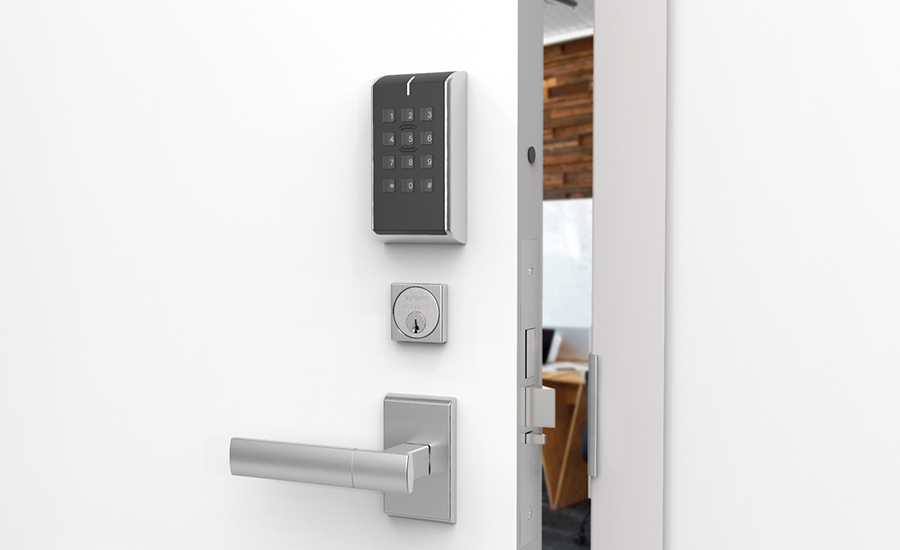ACCESS CONTROL & IDENTIFICATION
Improvements in Wireless Access
Wireless access control has come a long way in the past few years, and the advancements just keep coming.

While wired access will likely be used on the front door of most buildings, wireless solutions are perfect for indoor entrances.
IMAGE COURTESY OF ALLEGION

Wireless access control systems can assist users in contact tracing and other COVID-19 precautions.
IMAGE COURTESY OF ABLOY USA

There are many factors to consider when installing wireless access products, from the material of the walls in the building, to how many people will be flowing in and out.
IMAGE COURTESY OF ASSA ABLOY



Wireless access control has a bit of a bad rap. Connectivity issues, short battery lives and a lack of information have led to problems installing the technology over the years. But when installed properly, wireless access can be of great advantage to the security integrator and end user.
“Benefits range from easier installation, more jobs, more revenue and so on, to different offerings for customers,” says Scott McNulty, senior product manager, dormakaba Americas, Indianapolis. “Many wireless locks are a lot easier to install, and then you have the opportunity to sell more in different areas of a building, where before, you would only work on a front door [with wired access control]. Now, you can fit in a number of different places and really grow the footprint of what you’re offering your customers.”
Wireless also improves the control customers have over their facilities, and expands the support offerings integrators can provide, according to dormakaba Business Development Manager Dan Stewart.
“Another important advancement has been increased functionality that offers many of the same capabilities as wired access control, such as remote lockdown and scheduling,” adds Lisa Corte, director of product management, access and egress hardware group, ASSA ABLOY Opening Solutions Americas, New Haven, Conn.
Brian Telljohann, product manager, electronic locks, Allegion, Carmel, Ind., says that increased interoperability and cybersecurity of wireless access control products has made a world of difference over the past couple of years.
“I see wireless locks participating in the IoT, which improves interoperability between device manufacturers so we can interchange data more easily, which is most notably done on the IT network as opposed to hardwired systems,” Telljohann says. “There’s been an improvement in cybersecurity and people taking that more seriously, and there’s been a preference towards more network connected door openings.”
Integrator Brett Byrnes, chief technology officer and co-founder of TKS Security, Traverse City, Mich., sees the growing number of integrations as the biggest advancement. “It certainly seems that most established access control platforms (traditional software and hosted) now have integrations with wireless access control solutions,” Byrnes says.
Getting the Most Out of Wireless
When installing or selling wireless access control solutions, knowledge is power. There are so many things to consider, from the location of the lock, to Wi-Fi connectivity. Here, security professionals share tips and tricks on getting the most out of wireless access control:
“It’s important for integrators to have a larger, full picture conversation with customers. While the problems we are solving today may seem similar to before, with the current landscape, it may ultimately require a different solution. Integrators need to stay aware and engaged with their customer’s industry — understanding fully the new problems they are facing will be critical to providing solutions that exceed their needs.” — Sheeladitya Karmakar, Honeywell
“The features need to match the customer’s expectation. No matter who makes the wireless product, it is offline at some point, so making sure they understand there is no control or instant notification is essential.” — Dan Stewart, dormakaba
“We recommend our wireless solutions for temporary installations and places where it’s difficult to trench and pull wires, such as buildings which are long distances apart or where there are roads, parking lots or rivers that have to be spanned. Wireless is also great for places such as elevators or buildings where minimal disruption is desirable, such as when a building is historically significant or somewhere where there would be health issues with tearing out a wall or ceiling.” — Tony Diodato, Cypress Integration
“Spend a little time upfront, get educated on all of the offerings and try to focus on a few and get really good at those different brands. Sometimes we get calls from an integrator that has a problem and you learn it’s the first time they’re using the locks and they’re already on the job site, and we have to take over and help them.” — Rick Focke, Johnson Controls
“You want a product and solution that is simple to install, simple to use and actually works. One without the other is not acceptable. You also want door readers, wireless locks and video intercoms to all work together on one platform. One system, one platform and one manufacturer means only one number to call if something goes wrong.” — Jonathan Lach, Paxton Access
“Understand the wireless technology basics and be prepared to talk about it. IT staff should be asking you about the wireless encryption, for example, from the start. Don’t be afraid to mention it first.” — Brett Byrnes, TKS Security
“Look to the future. You have to look at expansion and where the company wants to grow.” — Anthony Dicato, integration engineer, Netronix
“Test, test, test. Make sure to know the proximity limitations and potential range issues.” — Saurabh Bajaj, Swiftlane
Technology Advances Shift Attitudes
Wireless access solutions just keep improving, according to integrators.
“In the beginning, wireless locks were barely more advanced than the technology in your garage door opener, with very basic wireless connections; but they’ve gotten better,” says John Rymer, application engineer at Netronix Integration, San Jose, Calif. “They keep moving forward to make them easier to install, so more people can install them, and faster; there’s not as much time invested just to get this thing to work.”
As the technologies improve, integrators are becoming more comfortable installing them, according to Mervi Hiltunen, business development and solutions director at ABLOY Critical Infrastructure Finland, Joensuu, Finland.
“Wireless locks have already experienced good interest and positive outlooks from systems integrators,” Hiltunen says. “Cloud services are also becoming more common and trusted.”
Saurabh Bajaj, CEO of Swiftlane, a wired access control company in San Francisco, says the consumerization of cloud services and mobile access is leading to an increase in the use of wireless access.
“In a world of accessibility, this is what people not only want but are familiar with,” Bajaj says. “Familiarity implies security; users are comfortable with what they know, which is why we are seeing a welcome shift in the access technology and security industry. Consequently, integrators are coming to us and embracing change because legacy systems are not satisfying their customer’s needs.”
Corte says as mobile credentials become increasingly present in wireless access, technology will continue rising in popularity.
“Wireless access offers an easy, affordable way to extend access control deeper into a facility and to more applications,” Corte says. “With the increased mobile capabilities and virtually the same functionality as wired access control, you get all the benefits you know and love about wired access control with even more flexibility.”
While many integrators are hesitant to use wireless access control, it is actually easier to install than wired access solutions, once you know what you are doing.
“In general, wireless access products are inherently easier to install as opposed to their hardwired counterparts since no wires are needed,” Telljohann says. “It can save [integrators] hours a day since they don’t have to run any cables.”
Despina Stamatelos, product marketing manager, Genetec, Montreal, says after seeing pushback from integrators over the years, the cost has decreased significantly.
“The locks themselves are still more expensive than a wired lock, but then look at the total cost of wiring,” Stamatelos says. “Look at the total cost of ownership.”
Plus, for integrators there is more money to be made due to the increased number of possible installations in a single building.
“The biggest advantage of the wireless locks is the price point to the customer versus a traditional wired access point,” says Brendan Cavanaugh, senior account manager, CGL Electronic Security, Westwood, Mass. “The front door of the building is likely going to be hardwired, but where wireless becomes an advantage to us as integrators is multiplying the number of doors we are touching for a customer — say a storage closet door that in the past a customer wouldn’t spend money putting access control on — and the wireless changes things so that can make sense for them. Now we’re touching more doors for the customer.”
These decreased costs have already aided the adoption rate.
“I’ve seen some lower cost models from suppliers, which helps to increase the adoption rate,” says Rick Focke, senior product manager, Johnson Controls, Milwaukee. “The locks are getting easier to configure — more out-of-the-box settings are there. [Integrators] are getting more comfortable, but [adoption] is not an overnight thing — it’s an evolution.”
Improved Wi-Fi connectivity has also turned many integrators into believers.
“You have less downtime, while with the older Wi-Fi, you’d have a lot of offline issues,” Rymer says. “Making that more stable not only makes it more usable for the customer, but then there are fewer service calls for us to go out and reconnect the locks.”
Wireless access also lessens cybersecurity concerns.
“Wireless in the security industry has been secure longer than wired has,” says Tony Diodato, founder and chief technology officer of Cypress Integration Solutions, Lapeer, Mich. “When used with SIA’s OSDP protocol, not only does it offer excellent encryption and authentication, but there are a host of other benefits, which we are working to incorporate into our products.”
Corte of ASSA ABLOY agrees that integrators have no reason to worry.
“One common question is whether there is any risk with transmitting data wirelessly; however, there has been a tremendous effort to protect against such dangers,” Corte says. “Wireless electronic access control technology is highly secure, and capable of using AES 128- or 256-bit encryption for the protection of data based on user needs.”
The range of wireless access solutions has also improved in recent years.
“One [of the biggest advancements in the past few years] would be the range between the pin and the gateway to the actual lock itself,” says integrator Rex Accavallo, CEO of The Royal Group, Rutland, Vt. “When they first came out, the range for wireless locks was very short, so being able to have a longer range makes it less expensive for the customer, and easier to design. Plus, the locks now function in offline modes, so if the network goes down at the customer site, the locks maintain the ability to read pins.”
Wireless Through the Decades
1980s
470 MHz industrial communications frequencies open “serial tunnel” for sending data over wires. Die to cost and FCC requirements, adoption is limited but effective in rare cases where wiring is impossible or exceedingly costly.
Mid-1990s
Switch to 900 MHz Spread Spectrum frequency. Site license no longer required. Smaller box size than earlier, with RS-232 connections. More than one per area, creates interference; requires pointing special directional antennas. Cost drops slightly, but use is limited mainly to special situations.
Late 1990s
Instead of using boxes, modules are plugged into circuit boards. Beginning of channel selection/some filtering. More units can co-exist in same area without interference. Cost is significantly less and use of wireless in security is increasing.
Early 2000s
Along with 900MHz, the 2.4 GHz frequency is introduced. Packets of data are routed automatically using transport layer of 802.15.4 protocol. Repeaters and mesh networking are introduced. The 802.15.4-compatible units become commercially available. Cost continues to decline.
2010-2015
Security products begin to transcend basic use of a wireless “serial tunnel” instead of wires for sending data. Product topology is beginning to take full advantage of the 802.15.4 packet structure. Cost decreases and use increases.
Current
Reliability, access and cost of bandwidth on cellular networks improves to the point where IoT devices and commercial hardware can afford to maintain a constant internet connection. The consumer electronics industry dramatically drives down the cost and improves the quality of short- and medium-range wireless technologies.
COVID-19 Use Cases Increase
The COVID-19 pandemic has only sped up all of these improvements.
“COVID-19 has underscored the lack of resilience in many building operations including access control,” Bajaj says. “Though there was already a shift in the industry to move towards touchless access control, the pandemic has aggressively fueled the expedition of that shift. We are going to see a rise in Bluetooth-enabled and near-field communication (NFC) technology that gives users frictionless access to buildings on top of the utilization of mobile credentials through cloud-based systems. This creates a healthier inside for occupants, a better experience all around for users and ease and scalability for facility managers.”
There are other features that make wireless access an appealing technology in the post-pandemic world, Corte says. “Most recently, with the COVID-19 pandemic, we are seeing that creative use of this existing infrastructure can also improve safety by managing traffic flow, limiting the number of people in a given area and allowing you to quickly change how a particular space is used. It can also support contact tracing and allow you to restrict access to areas if decontamination is required.”
According to Jonathan Lach, vice president of sales at Paxton Access, Greenville, S.C., all integrators should be talking to their clients about how these different use cases can help them through the pandemic.
“The COVID-19 pandemic has greatly influenced how we use access control,” Lach says. “We all need to take an active part in using access control to help make buildings and sites, big and small, more COVID-secure.”
If end users aren’t finding new use cases for their wireless access solutions that cater to the pandemic, they aren’t using the products to their full potential, according to Sheeladitya Karmakar, senior offering management lead, Honeywell Building Technologies, Atlanta.
“In our new normal, it’s important for customers to leverage their building systems to their full potential,” Karmakar says. “So, while many are using their access control systems from a security perspective, the system can also be leveraged to support contact tracing and other safety efforts. When used with exit readers, occupancy tracking will continue to be important as people continue to return to the space.”
And future advancements of wireless solutions will likely continue to cater to the new normal.
“The pandemic has had such an enormous impact on the world that the biggest advancements have, by necessity, been focused on helping organizations mitigate its effects,” says Stephen Carney, vice president of product marketing, physical access control solutions, HID Global, Austin, Texas. “The same pioneering wireless access innovations that have made organizations confident in the security of their facilities and assets are now also giving people the confidence that they are safe at work and on school campuses.”
Room to Improve
While wireless access control is growing in popularity, integrators still have their qualms about the technology.
“Hardwired access control is always considered first, before using wireless,” says Byrnes of TKS Security. “In my experience, some integrators are well-versed in wireless access control solutions while others may not even know that these solutions exist.”
According to Cavanaugh of CGL, while interoperability between devices is improving, issues can arise when integrating wireless access products from different manufacturers advancing at different rates.
“The manufacturer of the lock may certify it with a certain version of the software, but once that next version comes along, you sometimes see a breakdown in that compatibility,” Cavanaugh says. “So the challenge becomes being able to continually and regularly update the software and be confident that you aren’t going to break the integration between the wireless lock hardware and that system.”
Like with any technology, not everyone is going to jump on the wireless bandwagon at once. But over time, it could become the norm.
“If you look at video, nobody wanted to touch IP when it first came out, and look at where we are now,” says dormakaba’s McNulty. “There are always going to be people that fight it until the end; but as we keep going and the tech continues to evolve, we can fight back the reluctances of people to try it.”
Looking for a reprint of this article?
From high-res PDFs to custom plaques, order your copy today!









